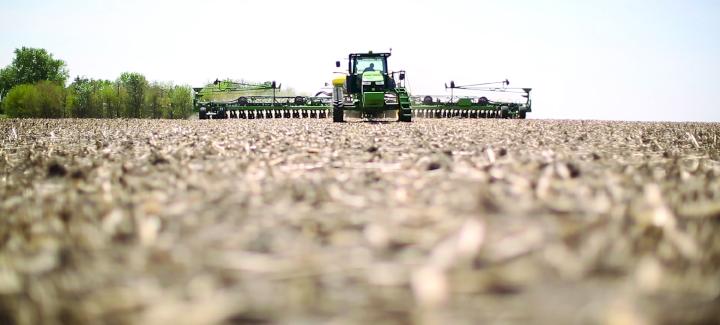
The May 23 Crop Progress Report states that 72% of the nation’s corn crop is in the ground, up from 49% last week. Of corn planted, 39% is emerged. For soybeans, 50% are planted, up from 30% last week. Corn planting is still 17% behind last year’s progress at this time, and soybeans are 23% behind last year’s planting numbers. Here’s what’s happening across the regions we serve:
Brian Burnell, Region 16 RSA (northern Indiana)
The northern half of Indiana has been very hit and miss. Just last Tuesday, I spoke with a grower on the southern edge who was done with corn and half done with soybeans, but the same day, a grower in the northern extreme still hadn’t planted anything. If I had to peg a number, I would say we are 65% done on corn and 40% on soybeans. I encourage growers to check soybean fields, especially as crusting has been a topic of conversation. I don’t think the issue is as big as it sounds, but we don’t want to miss a poor stand due to crusting and figure it out post spray time. Corn that is up looks great so far in my travels.
Katie Lorenz, Region 21 RSA (northern North Dakota)
North Dakota is, no doubt, the farthest behind this year when it comes to planting updates across the U.S. Saturated and cold soils from early spring snowfall and repeat rainfall are to blame. Slowly but surely the tractors and planters are starting to make their way from the shops to any dry dirt they can find. Corn planting is just underway, with only 20% of acres planted, well behind the 82% last year and the 67% average this time of year. Of the corn planted, only 1% has emerged, proving the cold spring temperatures are also well below average. For soybeans, only 7% of acres have been planted, whereas last year we were at 72%. We are all hoping the rain gives us a needed break to get these crops in the wet northern ground!
Jake Anderson, Region 12 RSA (western Illinois)
As in much of the Midwest, planting was delayed on account of wet field conditions and cool temperatures. Very little seed went in the ground in April. Things started picking up as May rolled around, and with the onset of a heatwave and clear forecast, it really broke loose. We’ve had a few rains since then but have been making steady progress. Some areas have experienced moderate amounts of replant as a result of crusted soil that had a negative impact on emergence. On the whole, our region is about 85% to 90% planted.
Chad Kuehl, Region 5 RSA (south central and southeastern Nebraska)
Lots of people are finishing up planting in Region 5 in southeast Nebraska. The biggest hurdle for a lot of growers in Nebraska was the constant wind that made it tough to get their pre sprayed ahead of soybean planting. With the warm weather last week, we saw corn emerging very quickly. We did have some cool temps this past weekend, where we saw a small amount of frost damage on soybeans in the northern part of my region (more on the no-till planted soybeans).
Dustin Ellis, Region 4 RSA (central Iowa)
Planting is close to complete for many growers in central Iowa. Like Nebraska, one big challenge growers faced in Iowa was frequent winds. This made it tough to put down their pre before soybeans were in the ground and corn emerged. We had 70+ degree temps last week, which allowed corn to emerge within six to seven days. Colder temps over the weekend slowed emergence in both corn and soybeans. That said, we just received much-needed rain on Tuesday and Wednesday, totaling close to 1.5 inches or more in some areas. The extended forecast looks great with some high 80-degree weather, which will get these last planted acres to emerge.
Aaron Stockton, Region 9 RSA (southeastern Kansas, southwestern Missouri, Oklahoma, northern Texas)
In Region 9, we have been battling the weather all spring. Growers have been able to find enough dry days here and there to get most of their corn in. As the calendar continues to tick by, and it gets later and later, the question is what to do with corn acres that are still unplanted.. Those decisions are being made now. There have been a few soybeans go in the ground so far, but we still have time to get those acres covered. Despite all the rain, we have seen most acres emerge with decent stand counts. All in all, we have been in worse shape before, and with a few dry days and a little sunshine, we can get back on track fairly quickly.
Bethany Oland, Region 7 RSA, (eastern South Dakota)
While southern areas of South Dakota have been abnormally dry this spring and the northern portion of the state substantially wet, the one common factor has been the wind. Field work, planting, and spraying have definitely been a challenge for Region 7. Growers in southern South Dakota are currently dealing with crusting and dust storms, which leads too emergence issues and wind damage. Sawing-off of soybeans has been an issue in certain areas.
While cold temperatures and moisture delayed planting in the north, growers are finally getting into the fields. I would expect corn to continue to be planted through Memorial Day weekend, then we’ll see a switch to soybeans.
For more information on planting progress or agronomic tips throughout the season, contact your local Stine sales rep.
Related Articles
-

Stine® to offer Syngenta’s Victrato® soybean seed treatment in 2026
December 2025 in Agronomy
-

Use Stine’s XP® seed treatments to prevent early injury to your crops
December 2025 in Agronomy
-

Understanding Stine’s enhanced oil profile soybeans
December 2025 in Agronomy
-

Soil sampling sets the stage for spring
November 2025 in Agronomy



